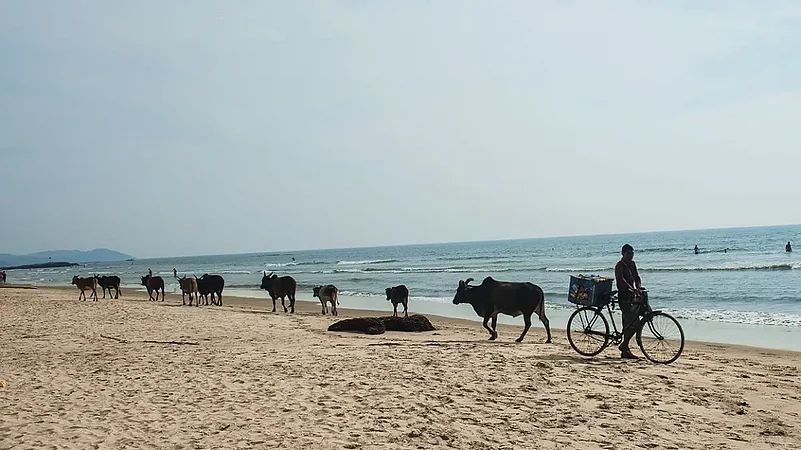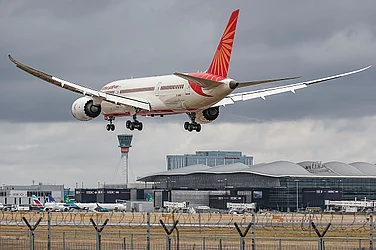Way back in March 2015, two first-term BJP chief ministers forked widely apart on one of their party’s most cherished platform ideals. Devendra Fadnavis was tweeting in jubilation about achieving “our dream” after President Pranab Mukherjee signed the long-pending Maharashtra Animal Preservation (Amendment) Bill to ban the slaughter and consumption of cows. But just across the border in Goa, Laxmikant Parsekar was assiduously dedicated to the opposite, even going to the extent of guaranteeing an uninterrupted supply of good quality, reasonably priced beef for the citizens of India’s smallest state.
At the time, Parsekar explained his logic in nuanced terms that make for fascinating reading, now that we have hurtled another seven years down the majoritarian highway: “I don’t think the people of any community eat or use beef to hurt the sentiments of others. It is part of their cuisine, and we accept the fact. This may be a tiny state, but our speciality is that Hindus, Catholics and Muslims can live together in harmony and peace. We know the importance of respecting others’ feelings. Therefore, such issues are never blown out of proportion as in other states.”
In an especially revealing conversation with a business daily, Parsekar elaborated that “regardless of what the Centre does—in Goa minorities are 39-40 per cent—if it is part of their food habits, why and how can we ban it? I feel it should not be banned.” He shared his experience as one of the first members of the BJP who built the party in the state: “It has been a gradual, gradual growth. We reaped the confidence of the minorities in particular, and came to power on minority support. In Goa, we are always one step ahead in reassuring the minority communities.”
Fast forward to 2022, and all those pluralistic sentiments are just ancient history. The new BJP in Goa is so different that even Parsekar has no place in it. He was compelled to compete as an independent in the elections earlier this year, and lost quite badly. Meanwhile, the perennially beleaguered chief minister Pramod Sawant has shifted fast from communally-tinged dog whistles on the campaign trail to machinating overtime to wedge apart the famous harmony his predecessor was talking about.
It should be noted that Sawant has been needling in this direction for years. In 2018, he told Goans that it was inappropriate for them to root for the Portugal football team. Even more recently, in the 2022 elections cycle, he suddenly started pleading with voters: “I do not ask for anything [more], I just request you for the strength to preserve Hindu and temple culture and re-establish those temples and culture [that were damaged or destroyed in the colonial period].” Just after taking office last month, the chief minister’s inaugural budget set aside Rs 20 crore “for the restoration of temples”. And on Good Friday recently, Sawant made yet another declaration that “once again [our] religion is being attacked. I am not telling lies. We have seen that in various parts of Goa, people are moving forward towards religious conversion. Taking advantage of different things—someone is poor, someone is a numerical minority, somebody is backward, someone who does not have food or a job—such people are being taken (in) in this manner. The government will never allow religious conversions, but people need to be vigilant.” The chief minister hasn’t yet mentioned beef, but politics of conversion are inextricably tied to intense feelings about food and ritual pollution, which are linked together in the complex landscapes of identity and belonging evoked by what we eat, and—even more importantly—what we are seen to be eating.
This has always been a potent issue in the wildly omnivorous Konkan, where every kind of meat has always been relished, from wild boar to fruit bat. Here, where even the most observant upper caste Hindu communities happily gorge on fish curry and rice, there have always been deep-seated anxieties about how to position these flourishing food habits. Goa University historian Parag Parobo points out in his India’s First Democratic Revolution: Dayanand Bandodkar and the Rise of Bahujan in Goa that, for centuries, “Maharashtrian Brahmans such as Chitpavans, Karhades, Padyes and Kirvants refused to acknowledge [the status of Goan Brahmins]”. There is considerable irony that it was actually the British and Portuguese courts that legislated into existence the newly-named “Gaud Saraswat Brahmins” (GSBs).
ALSO READ: Food Apartheid: Non-vegetarians Not Allowed!
Those elaborate deliberations—along with the construction of a previously non-existent GSB identity—came after centuries of another kind of food politics in Goa, where beef and pork were projected as important markers of Portuguese and Catholic identity. In this regard, it is rather curious to note how Sawant’s latest rumblings distinctly echo the colonial bigotries that previously attempted to forcibly cleave apart Goans on the basis of religion. As the insightful IIT Bombay scholar Rowena Robinson describes in her 1993 paper for Sociological Bulletin, “The Portuguese were aware that eating food with strangers defiled the Hindu. It involved a pollution so great that the person found guilty of it was rendered an outcaste and no social relationships could be entered into with him.”
ALSO READ: What Ignites Hatred In The Belly?
Robinson recounts, “We have evidence that meat-eating was not taboo among the lowest Hindu castes and that deities were often honoured with animal sacrifices. For them the adoption of a meat-centred diet would have been no wrench. This may also have made Catholicism seem less alien to them.” She also explains, “It is not unlikely that the stress the Portuguese laid on converting the Hindus through the use of beef and pork had some relation to their attempt to transplant the staples of their own diet in the new world they had conquered.”
ALSO READ: Caste On A Platter: Food For Dalits
These caveats notwithstanding, the use of food to provoke and pollute was routine in Goa in the first decades of Portuguese conquest. There is a particularly vivid illustration in a story recounted by Robinson about a 16th century Goan woman whose “son had been made to eat beef at the house of a Christian [and] ran to Father Pedro d’Almeida in tears and said that she wanted to become a Christian because her son had eaten beef and thus already become one. Having eaten food at a Christian’s house, the boy had, in effect, lost his caste and his place in the circle of kinship. For his mother, then, little remained but to follow suit. Not just individuals but whole families, kin groups and local caste groupings could be converted in this way.”
ALSO READ: Mid-Day Meal Scheme: We Need No Politics

This is a deeply dismaying history, and there is no denying its painful impact on Goan society. Yet, it’s equally true that those dismaying episodes played out well over 400 years ago, and—just as Parsekar said in 2015—Goans have long since evolved what he described as “the speciality” of living with each other in remarkable harmony, in the practice of their many-layered culture where sectarian divisions present far less of a problem than most of the rest of the subcontinent. In this legendarily laidback slice of the west coast of India, nobody cares very much how you worship, dress, or eat, as long as you respect the same rights of everybody else.
This is why, when a beef ban was imposed in Maharashtra, the wonderfully genial owner of my family’s go-to meat supplier in Panjim was visibly distressed. Raj Maganlal told me the move was an unfair tax on the poor: “I am a Hindu, I am a Gujarati Hindu, but I eat beef. It is by far the most reasonably priced protein in the state—no other meat compares.” We discussed how many Goans who didn’t cook beef at home still frequent cutlet pao stalls, as delicious beef “crumb chops” are the signature street food of the state. Meanwhile, urban elites on vacation feed an insatiable demand for the burgers and steaks they can’t get back home—the unstoppable appeal of Goa in 2022 is precisely the freedoms that are being rapidly encroached upon in other parts of the country.
The great Konkani writer Damodar Mauzo, who won the 57th Jnanpith Award in 2021, has written an insightful short story on this topic. In the Land of Humans (it’s included in the 2014 collection Teresa’s Man) introduces us to Halsid’du, who is walking his small knot of cattle across the Karnataka border to be sold to a slaughterhouse in Goa. It is not an easy journey—nothing in his life has been without its own struggle—but he keeps recalling the words of his father, who had once followed Ambedkar’s dictum to seek upliftment via education but failed to find any way out, “he hadn’t come up in life”.
ALSO READ: A Pandit Must Know His Meat
Halsid’du recounts: “Many children from Mharvaddo, the ghetto where the scheduled castes of the village lived, went to school. Some even reached high school. Those who went to Khanapur and Belgaum did better for themselves than those who stayed back. But Appu had seen a better world elsewhere. Some of his acquaintances had migrated to Goa and Appu had visited them a few times. Having seen the lives they led there, Appu had advised Halsid’du, “It doesn’t matter if you don’t get much of an education, but see that when you’ve grown up, you go to Goa. You’ll live like a human being there.”
ALSO READ: Mise En Place for Mise-En-Scène
In his typically compelling minimalist style, Mauzo portrays the extreme poverty of Halsid’du’s milieu. “The bellies of the farmers were hollowed out by hunger and their stomachs were now touching their backbones,” he writes. “Even in the homes of those who were better off, the fires were lit just once to cook the sole meal of the day. If this was the state that humans lived in, could they even think of the animals?” All those concerns began to lift as he came closer to the border. Even “the vegetation turned greener the closer they came to Goa.” Then the moment of truth, along with these exhaled aspirations, “Thank God! I have reached at last. I must look out for work here. I must look for a place to stay. I have to become a man [here].” But then comes the first inkling of danger: “A meeting was in progress near a temple along the road. A man wearing a long kurta was making a loud speech, and was being frequently applauded by the gathering. Halsid’du slowed down. The sun had started to dazzle his eyes. Hunger was gnawing at him.”
Unbeknownst to him, because he did not speak the language of these people, trouble was brewing fast for the ill-fated young man: “The speaker thundered into the mike, ‘See for yourselves. Do we revere the cow as our mother and Nandi the bull as the vehicle of God Shiva or do we not? We can eat only because these cattle plough our fields! Are we then going to fold our arms and watch mutely as these cattle are being taken to be butchered?’ ” The onlookers “took off like an incensed mob.” They chased after the hapless cowherder “like a swarm of enraged bees.” Mauzo writes with great power and sorrow, “The great lovers of animals pounded Halsid’du to their heart’s content. At the end of it all, Halsid’du was left wondering why he had been beaten black and blue by those who lived in this land of humans.”
(Views expressed are personal)
Vivek Menezes is a writer and photographer, and co-founder of the Goa Arts+literary festival


























